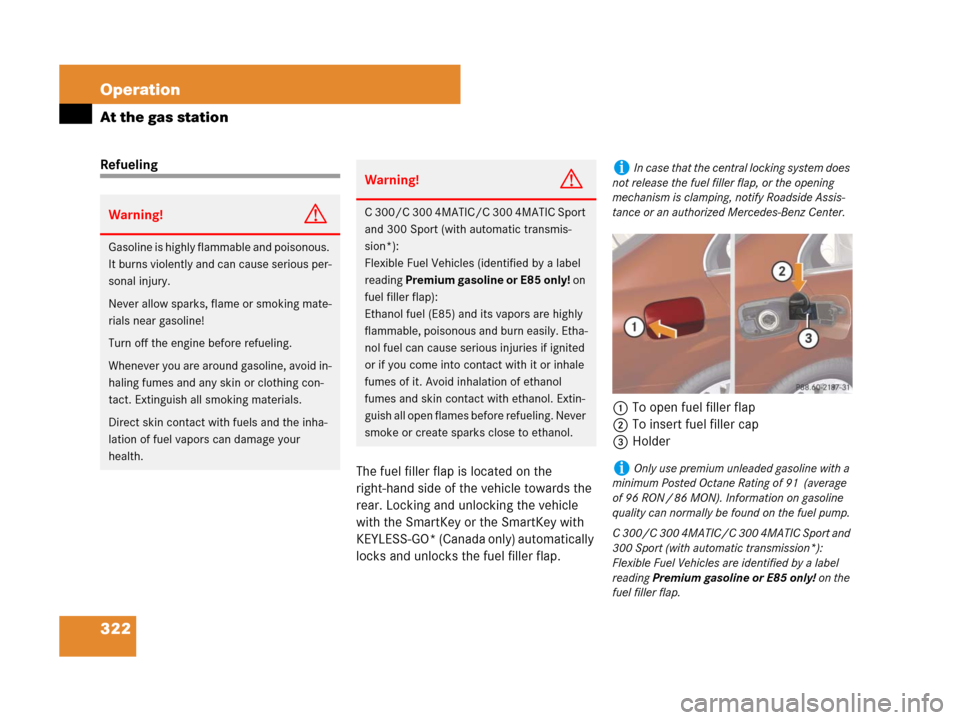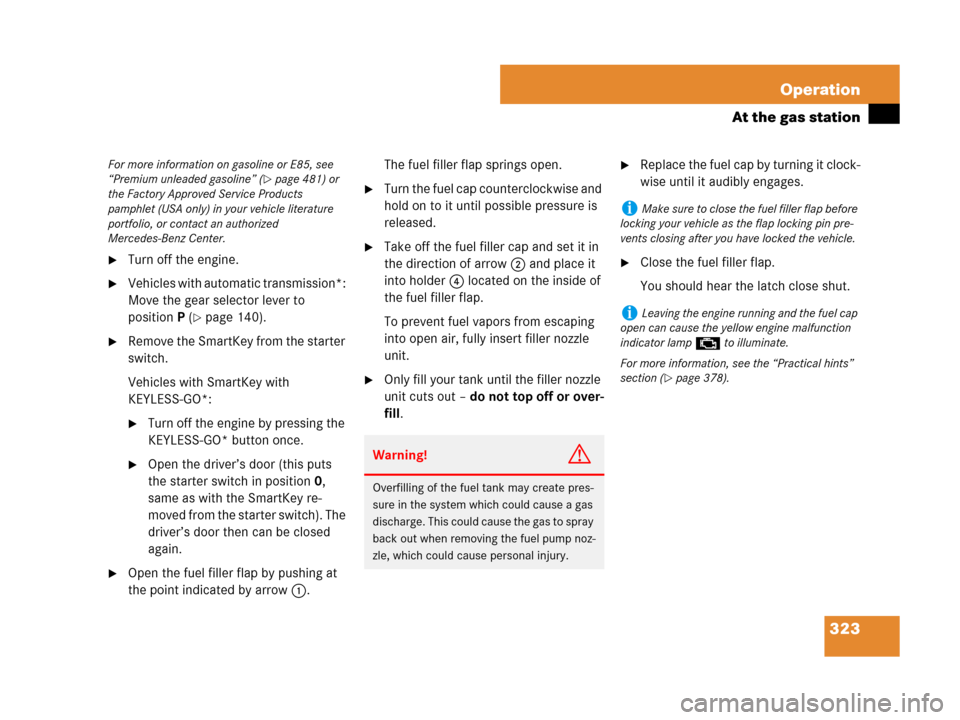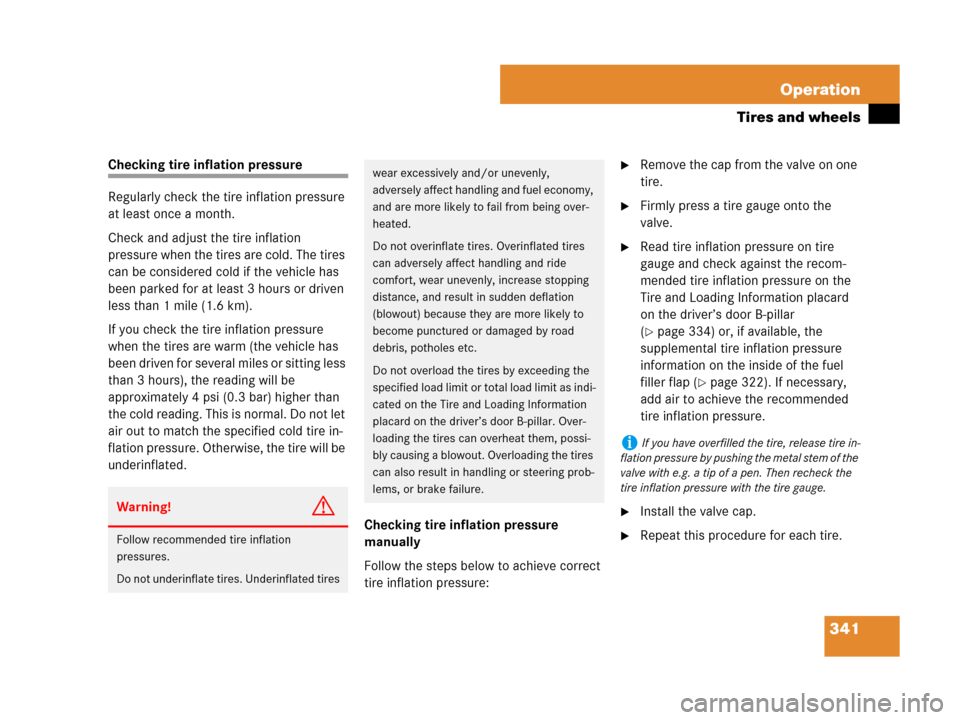Page 323 of 509

322 Operation
At the gas station
Refueling
The fuel filler flap is located on the
right-hand side of the vehicle towards the
rear. Locking and unlocking the vehicle
with the SmartKey or the SmartKey with
KEYLESS-GO* (Canada only) automatically
locks and unlocks the fuel filler flap.1To open fuel filler flap
2To insert fuel filler cap
3Holder
Warning!G
Gasoline is highly flammable and poisonous.
It burns violently and can cause serious per-
sonal injury.
Never allow sparks, flame or smoking mate-
rials near gasoline!
Turn off the engine before refueling.
Whenever you are around gasoline, avoid in-
haling fumes and any skin or clothing con-
tact. Extinguish all smoking materials.
Direct skin contact with fuels and the inha-
lation of fuel vapors can damage your
health.
Warning!G
C 300/C 300 4MATIC/C 300 4MATIC Sport
and 300 Sport (with automatic transmis-
sion*):
Flexible Fuel Vehicles (identified by a label
reading Premium gasoline or E85 only! on
fuel filler flap):
Ethanol fuel (E85) and its vapors are highly
flammable, poisonous and burn easily. Etha-
nol fuel can cause serious injuries if ignited
or if you come into contact with it or inhale
fumes of it. Avoid inhalation of ethanol
fumes and skin contact with ethanol. Extin-
guish all open flames before refueling. Never
smoke or create sparks close to ethanol.
iIn case that the central locking system does
not release the fuel filler flap, or the opening
mechanism is clamping, notify Roadside Assis-
tance or an authorized Mercedes-Benz Center.
iOnly use premium unleaded gasoline with a
minimum Posted Octane Rating of 91 (average
of 96 RON / 86 MON). Information on gasoline
quality can normally be found on the fuel pump.
C 300/C 300 4MATIC/C 300 4MATIC Sport and
300 Sport (with automatic transmission*):
Flexible Fuel Vehicles are identified by a label
reading Premium gasoline or E85 only! on the
fuel filler flap.
Page 324 of 509

323 Operation
At the gas station
�Turn off the engine.
�Vehicles with automatic transmission*:
Move the gear selector lever to
positionP (
�page 140).
�Remove the SmartKey from the starter
switch.
Vehicles with SmartKey with
KEYLESS-GO*:
�Turn off the engine by pressing the
KEYLESS-GO* button once.
�Open the driver’s door (this puts
the starter switch in position0,
same as with the SmartKey re-
moved from the starter switch). The
driver’s door then can be closed
again.
�Open the fuel filler flap by pushing at
the point indicated by arrow 1.The fuel filler flap springs open.
�Turn the fuel cap counterclockwise and
hold on to it until possible pressure is
released.
�Take off the fuel filler cap and set it in
the direction of arrow 2 and place it
into holder 4 located on the inside of
the fuel filler flap.
To prevent fuel vapors from escaping
into open air, fully insert filler nozzle
unit.
�Only fill your tank until the filler nozzle
unit cuts out – do not top off or over-
fill.
�Replace the fuel cap by turning it clock-
wise until it audibly engages.
�Close the fuel filler flap.
You should hear the latch close shut.
For more information on gasoline or E85, see
“Premium unleaded gasoline” (
�page 481) or
the Factory Approved Service Products
pamphlet (USA only) in your vehicle literature
portfolio, or contact an authorized
Mercedes-Benz Center.
Warning!G
Overfilling of the fuel tank may create pres-
sure in the system which could cause a gas
discharge. This could cause the gas to spray
back out when removing the fuel pump noz-
zle, which could cause personal injury.
iMake sure to close the fuel filler flap before
locking your vehicle as the flap locking pin pre-
vents closing after you have locked the vehicle.
iLeaving the engine running and the fuel cap
open can cause the yellow engine malfunction
indicator lamp ± to illuminate.
For more information, see the “Practical hints”
section (
�page 378).
Page 342 of 509

341 Operation
Tires and wheels
Checking tire inflation pressure
Regularly check the tire inflation pressure
at least once a month.
Check and adjust the tire inflation
pressure when the tires are cold. The tires
can be considered cold if the vehicle has
been parked for at least 3 hours or driven
less than 1 mile (1.6 km).
If you check the tire inflation pressure
when the tires are warm (the vehicle has
been driven for several miles or sitting less
than 3 hours), the reading will be
approximately 4 psi (0.3 bar) higher than
the cold reading. This is normal. Do not let
air out to match the specified cold tire in-
flation pressure. Otherwise, the tire will be
underinflated.
Checking tire inflation pressure
manually
Follow the steps below to achieve correct
tire inflation pressure:�Remove the cap from the valve on one
tire.
�Firmly press a tire gauge onto the
valve.
�Read tire inflation pressure on tire
gauge and check against the recom-
mended tire inflation pressure on the
Tire and Loading Information placard
on the driver’s door B-pillar
(
�page 334) or, if available, the
supplemental tire inflation pressure
information on the inside of the fuel
filler flap (
�page 322). If necessary,
add air to achieve the recommended
tire inflation pressure.
�Install the valve cap.
�Repeat this procedure for each tire.
Warning!G
Follow recommended tire inflation
pressures.
Do not underinflate tires. Underinflated tires
wear excessively and/or unevenly,
adversely affect handling and fuel economy,
and are more likely to fail from being over-
heated.
Do not overinflate tires. Overinflated tires
can adversely affect handling and ride
comfort, wear unevenly, increase stopping
distance, and result in sudden deflation
(blowout) because they are more likely to
become punctured or damaged by road
debris, potholes etc.
Do not overload the tires by exceeding the
specified load limit or total load limit as indi-
cated on the Tire and Loading Information
placard on the driver’s door B-pillar. Over-
loading the tires can overheat them, possi-
bly causing a blowout. Overloading the tires
can also result in handling or steering prob-
lems, or brake failure.
iIf you have overfilled the tire, release tire in-
flation pressure by pushing the metal stem of the
valve with e.g. a tip of a pen. Then recheck the
tire inflation pressure with the tire gauge.